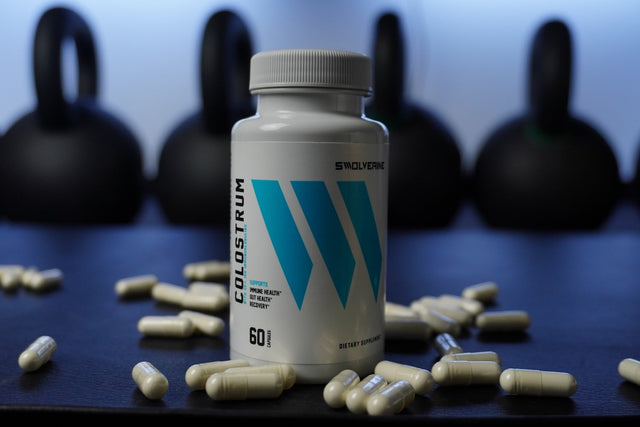In the intricate world of hormones, dihydrotestosterone (DHT) often finds itself shrouded in mystery. This powerful androgen, a derivative of testosterone, plays a significant role in various aspects of health, from hair growth to prostate function. Despite its importance, many people remain unaware of how DHT impacts their well-being and the delicate balance it maintains within the body. Understanding DHT isn’t just for those experiencing hair loss or hormonal imbalances; it’s crucial for anyone looking to optimize their health.
In this article, we’ll delve into the science behind dihydrotestosterone, unraveling its functions, potential effects, and why it deserves a prominent place in the conversation about overall health.
Whether you're curious about its effects on physical appearance or its role in men's health, unlocking the mysteries of DHT can empower you to take charge of your well-being and make informed decisions. Join us as we explore why dihydrotestosterone matters and how it can influence your health journey.
Unlocking the Mystery: What is Dihydrotestosterone and Why It Matters for Your Health
In the intricate world of hormones, dihydrotestosterone (DHT) often finds itself shrouded in mystery. This powerful androgen, a derivative of testosterone, plays a significant role in various aspects of health, from hair growth to prostate function. Despite its importance, many people remain unaware of how DHT impacts their well-being and the delicate balance it maintains within the body.
Understanding DHT isn’t just for those experiencing hair loss or hormonal imbalances; it’s crucial for anyone looking to optimize their health. In this article, we’ll delve into the science behind dihydrotestosterone, unraveling its functions, potential effects, and why it deserves a prominent place in the conversation about overall health. Whether you're curious about its effects on physical appearance or its role in men's health, unlocking the mysteries of DHT can empower you to take charge of your well-being and make informed decisions.
What is DHT? The Science Behind How It’s Produced
Dihydrotestosterone (DHT) is produced in the body through the conversion of testosterone, the primary male sex hormone. This conversion is facilitated by an enzyme called 5-alpha-reductase, which is present in various tissues including the skin, prostate, liver, and hair follicles.
When testosterone interacts with 5-alpha-reductase, it is biochemically transformed into DHT—a more potent androgen with a significantly higher binding affinity for androgen receptors. These receptors are present in many types of cells throughout the body, enabling DHT to play a major role in multiple physiological processes (Cleveland Clinic, 2022).
DHT's Role in Male and Female Physiology
The production of DHT is natural and essential to male development. During puberty, DHT is largely responsible for the formation of primary and secondary sexual characteristics such as:
-
Growth of facial and body hair
-
Deepening of the voice
-
Development of male genitalia
While testosterone initiates these changes, DHT often serves as the more biologically active form of the hormone, making it especially crucial during these stages of growth (Harvard Health, 2023).
In females, DHT exists in much smaller quantities, yet it still plays roles in:
-
Maintaining libido
-
Supporting hair follicle health
-
Regulating certain androgen-sensitive tissues
Genetics, Enzyme Activity, and Health Implications
The levels of both 5-alpha-reductase and testosterone—and by extension, DHT—can vary widely between individuals. Key factors influencing these levels include:
-
Genetics
-
Age
-
Overall health and metabolic function
Certain genetic polymorphisms can result in increased 5-alpha-reductase activity, which may lead to higher circulating DHT levels. Elevated DHT has been linked to conditions such as:
-
Androgenic alopecia (pattern hair loss)
-
Benign prostatic hyperplasia (BPH)
-
Acne and oily skin
For example, a study published in Dermatologic Therapy notes that men with higher levels of scalp DHT are more likely to experience male pattern baldness (Trueb, 2003).
Why DHT Matters in Your Health Journey
Understanding how DHT is produced and its role in the body can help individuals make informed decisions regarding their health. If you’re experiencing symptoms like hair thinning, prostate issues, or hormonal imbalances, it's worth exploring how DHT might be playing a part.
In certain cases, medical interventions such as 5-alpha-reductase inhibitors (e.g., finasteride) may be prescribed to reduce DHT levels and help manage conditions like hair loss or BPH. However, lowering DHT can also come with side effects, including decreased libido and mood changes, so it's essential to work with a healthcare provider.
For those looking to naturally balance their hormone levels, lifestyle factors such as:
-
Resistance training
-
Stress management
-
A diet rich in zinc and omega-3 fatty acids
...may also support healthy androgen levels without drastic interventions.
DHT isn’t just a hormone that affects hairlines and hormone therapy—it’s a powerful molecule with widespread implications for your physical, sexual, and even emotional health. Gaining a deeper understanding of how DHT functions can help you become more proactive in managing your health, whether you're a man navigating age-related hormonal shifts or a woman seeking answers about unexplained symptoms.
DHT and Hormonal Balance: Understanding the Connection
Hormonal balance is a delicate and intricate system where even small fluctuations can have significant impacts on your overall health. Dihydrotestosterone (DHT) is a part of this complex network, and its levels must be carefully regulated to maintain equilibrium.
DHT, Testosterone, and the Hormonal Cascade
One of the primary interactions of DHT is with testosterone. While testosterone serves as a precursor to DHT, the two hormones must be properly balanced. Excessive conversion of testosterone to DHT—often due to elevated 5-alpha-reductase activity—can result in reduced free testosterone levels, potentially affecting:
-
Libido
-
Energy
-
Muscle mass
As cited by Harvard Health Publishing (2023), this hormonal imbalance is a frequent concern among men experiencing symptoms of low testosterone or age-related andropause (Harvard Health).
DHT, Estrogen, and Gender-Based Differences
The interplay between DHT and estrogen, the primary female sex hormone, also plays a crucial role in maintaining hormonal balance. Both men and women produce estrogen, and disruptions in this balance can trigger various health concerns:
-
In men, high DHT with low estrogen may contribute to:
-
Benign prostatic hyperplasia (BPH)
-
Androgenic alopecia (pattern hair loss)
-
-
In women, elevated DHT can result in:
-
Hyperandrogenism
-
Hirsutism (excessive body hair)
-
Polycystic ovary syndrome (PCOS)
-
A 2018 review in Frontiers in Endocrinology confirmed that DHT-driven androgen excess plays a central role in the pathophysiology of PCOS in women (Rosenfield, 2018).
Cortisol, Stress, and the DHT Feedback Loop
Another important piece in the hormonal puzzle is cortisol, the body’s primary stress hormone. Chronic stress leads to elevated cortisol, which can interfere with DHT levels in several ways:
-
Increases 5-alpha-reductase activity
-
Elevates DHT production
-
Contributes to a feedback loop of stress and hormonal imbalance
As outlined in The Journal of Investigative Dermatology (Sawaya, 2001), cortisol-driven increases in DHT can exacerbate conditions such as hair loss, acne, and prostate issues (Sawaya, 2001).
Understanding these interactions supports a more holistic approach to managing stress and maintaining overall hormonal health.
Effects of DHT on Hair Health
One of the most widely recognized effects of DHT is its influence on hair health, particularly regarding hair loss. Androgenic alopecia, commonly referred to as male or female pattern baldness, is strongly tied to elevated DHT levels.
How DHT Causes Hair Follicle Miniaturization
In genetically predisposed individuals, hair follicles are especially sensitive to DHT. The hormone binds to androgen receptors in the scalp, initiating a process called miniaturization, where:
-
Hair shafts become thinner
-
Hair cycles shorten
-
Eventually, hair growth stops
According to research published in The Journal of Investigative Dermatology, DHT alters the anagen (growth) and telogen (resting) phases, contributing to excessive shedding and diminished regrowth (Randall, 2008).
Why Not Everyone with High DHT Loses Hair
It’s important to note that high DHT does not guarantee hair loss. Several factors influence individual responses:
-
Genetic sensitivity of hair follicles
-
Nutritional status
-
Stress levels
-
Overall metabolic health
Treatment options for DHT-related hair loss may include:
-
Finasteride – a 5-alpha-reductase inhibitor
-
Minoxidil – a topical treatment that supports hair growth independently of DHT
These therapies aim to reduce DHT or its effects on follicles while promoting regrowth and preserving remaining hair.
DHT and Its Impact on Prostate Health
DHT is essential to the development and function of the prostate gland, but problems can arise when levels are excessively high.
DHT and Benign Prostatic Hyperplasia (BPH)
Benign prostatic hyperplasia (BPH)—a non-cancerous enlargement of the prostate—is a common condition among aging men. Elevated DHT levels are a major driver of this condition, promoting prostate cell growth via androgen receptor activation.
Symptoms include:
-
Urinary frequency
-
Difficulty initiating urination
-
Incomplete bladder emptying
Research from the Mayo Clinic and Urology Journal underscores the pivotal role of DHT in the pathogenesis of BPH (Mayo Clinic).
DHT and Prostate Cancer Risk
While DHT is not directly carcinogenic, it can support the growth of existing prostate cancer cells. In predisposed individuals, DHT helps sustain the proliferation of both normal and abnormal prostate tissue. That’s why androgen deprivation therapy (ADT)—which lowers circulating androgens—is a frontline treatment for advanced prostate cancer.
A study in The New England Journal of Medicine found that reducing DHT can significantly slow the progression of prostate tumors in high-risk patients (Crawford et al., 2009).
Supporting Prostate Health and Hormonal Balance
Managing DHT levels isn’t just about prescriptions. Lifestyle interventions can make a big difference, such as:
-
Anti-inflammatory diet (rich in omega-3s, cruciferous vegetables)
-
Consistent exercise
-
Regular screenings for prostate size and function
-
Stress reduction via meditation, yoga, or therapy
These practices support hormonal harmony and help mitigate the potential negative effects of DHT on prostate and overall health.
The Link Between DHT and Other Health Conditions
The influence of dihydrotestosterone (DHT) extends beyond hair loss and prostate health, affecting several other aspects of physical well-being. Elevated DHT has been implicated in conditions such as acne, metabolic syndrome, and cardiovascular disease, making it a hormone worth monitoring as part of a broader health strategy.
DHT and Acne: A Common Hormonal Trigger
One of the most visible effects of elevated DHT is the development of acne, particularly during puberty. DHT stimulates the sebaceous glands to produce sebum, an oily substance that can clog pores and trigger breakouts. This is not limited to teenagers—adults with elevated DHT levels may also experience persistent or cyclical acne.
A study in The Journal of Clinical and Aesthetic Dermatology confirms the androgen-driven nature of acne, specifically noting DHT’s impact on sebaceous activity (Zaenglein, 2018).
DHT and Metabolic Health: The Hidden Connection
Research has shown a potential link between high DHT levels and metabolic syndrome—a cluster of risk factors that include:
-
High blood pressure
-
Elevated blood glucose
-
Abdominal obesity
-
Abnormal cholesterol levels
DHT's involvement here relates to its influence on insulin sensitivity, fat distribution, and glucose metabolism. A 2020 study published in Endocrinology found that excess DHT may disrupt metabolic homeostasis, particularly in individuals with androgen receptor sensitivity (Liu et al., 2020).
DHT and Cardiovascular Risk
Elevated DHT has also been linked to cardiovascular disease, including:
-
Hypertension
-
Atherosclerosis
-
Dyslipidemia
The mechanisms are complex but involve DHT’s effects on lipoproteins, vascular inflammation, and arterial plaque formation. According to research in The Journal of Steroid Biochemistry and Molecular Biology, DHT can negatively influence endothelial function and lipid metabolism, contributing to long-term vascular risk (Gao et al., 2007).
Managing DHT Levels: Natural and Medical Approaches
Medical Options
One of the most effective medical methods for managing DHT involves 5-alpha-reductase inhibitors, such as:
-
Finasteride
-
Dutasteride
These medications work by inhibiting the conversion of testosterone into DHT, and are often prescribed for:
-
Androgenic alopecia
-
Benign prostatic hyperplasia (BPH)
While effective, these drugs can carry side effects such as reduced libido, erectile dysfunction, and mood changes, as detailed in Mayo Clinic's prescribing guidelines (Mayo Clinic).
Natural Approaches
For those preferring a natural route, several dietary and lifestyle strategies may help regulate DHT production:
-
Zinc (found in pumpkin seeds and shellfish): Helps inhibit 5-alpha-reductase
-
Lycopene (from tomatoes): Has antioxidant properties that reduce DHT
-
Beta-sitosterol (in avocados, nuts): Blocks DHT from binding to androgen receptors
Other key lifestyle strategies include:
-
Regular exercise – boosts hormonal regulation and reduces 5-alpha-reductase activity
-
Stress management – lowers cortisol, which can otherwise increase DHT
-
Maintaining a healthy weight – as excess fat can raise DHT via increased enzyme activity
As supported in Nutrients journal, these interventions can significantly impact hormonal balance and reduce DHT-related symptoms (Wang et al., 2021).
Common Myths About DHT
Myth 1: DHT Is the Sole Cause of Hair Loss
While DHT plays a central role in androgenic alopecia, it's not the only factor. Hair loss is influenced by:
-
Genetics
-
Nutrient deficiencies
-
Chronic stress
-
Scalp inflammation
Effective treatment often requires a multi-pronged approach, not just hormone management.
Myth 2: Lowering DHT Cures All Prostate Problems
Another common misconception is that reducing DHT levels eliminates prostate issues. While lowering DHT can ease symptoms of BPH and slow prostate cancer progression, lifestyle, genetics, and diet also significantly affect prostate health.
Comprehensive care should include:
-
Medical screenings
-
Dietary changes
-
Exercise routines
-
Stress management
Myth 3: DHT Is Only a Concern for Men
Though DHT is more dominant in men, women also produce and are affected by DHT. Elevated DHT levels in women can cause:
-
Polycystic ovary syndrome (PCOS)
-
Hirsutism
-
Hormonal acne
A better understanding of DHT’s role in female physiology is critical for accurate diagnosis and treatment of these conditions.
As detailed in The Lancet Diabetes & Endocrinology, PCOS is one of the most underdiagnosed conditions tied to elevated androgens like DHT (Azziz et al., 2016).
Conclusion: The Importance of Understanding DHT for Overall Health
Unlocking the mystery of dihydrotestosterone (DHT) is vital for anyone looking to optimize their health and well-being. This powerful androgen influences various aspects of physical and mental health, from hair growth and prostate function to metabolic and cardiovascular health. Understanding how DHT is produced, its role in the body, and its interplay with other hormones can provide valuable insights into managing conditions associated with elevated DHT levels.
Whether dealing with hair loss, acne, or prostate issues, knowing the impact of DHT can empower individuals to take proactive steps toward better health. Both natural and medical approaches can be effective in managing DHT levels, and a comprehensive strategy that includes dietary changes, lifestyle modifications, and, when necessary, pharmaceutical interventions can offer the best outcomes. Dispelling common myths about DHT can also help individuals make informed decisions about their health and seek appropriate treatments.
In conclusion, understanding DHT is not just for those experiencing specific health issues; it is crucial for everyone. By unlocking the mysteries of DHT, individuals can gain a deeper appreciation of their hormonal health and take charge of their well-being. Whether through medical treatments, natural approaches, or a combination of both, managing DHT levels can lead to improved health outcomes and a better quality of life.







